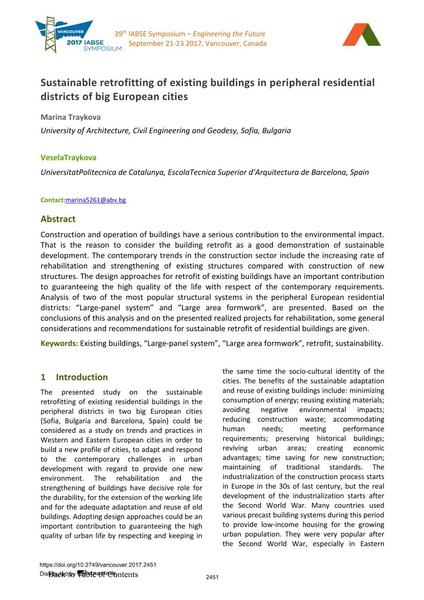Sustainable retrofitting of existing buildings in peripheral residential districts of big European cities

|
|
|||||||||||
Bibliografische Angaben
| Autor(en): |
Marina Traykova
(University of Architecture, Civil Engineering and Geodesy, Sofia, Bulgaria)
Vesela Traykova (UniversitatPolitecnica de Catalunya, EscolaTecnica Superior d’Arquitectura de Barcelona, Spain) |
||||
|---|---|---|---|---|---|
| Medium: | Tagungsbeitrag | ||||
| Sprache(n): | Englisch | ||||
| Tagung: | IABSE Symposium: Engineering the Future, Vancouver, Canada, 21-23 September 2017 | ||||
| Veröffentlicht in: | IABSE Symposium Vancouver 2017 | ||||
|
|||||
| Seite(n): | 2451-2457 | ||||
| Anzahl der Seiten (im PDF): | 7 | ||||
| Jahr: | 2017 | ||||
| DOI: | 10.2749/vancouver.2017.2451 | ||||
| Abstrakt: |
Construction and operation of buildings have a serious contribution to the environmental impact. That is the reason to consider the building retrofit as a good demonstration of sustainable development. The contemporary trends in the construction sector include the increasing rate of rehabilitation and strengthening of existing structures compared with construction of new structures. The design approaches for retrofit of existing buildings have an important contribution to guaranteeing the high quality of the life with respect of the contemporary requirements. Analysis of two of the most popular structural systems in the peripheral European residential districts: “Large-panel system” and “Large area formwork”, are presented. Based on the conclusions of this analysis and on the presented realized projects for rehabilitation, some general considerations and recommendations for sustainable retrofit of residential buildings are given. |
||||
| Stichwörter: |
Nachhaltigkeit Retrofit
|
||||
